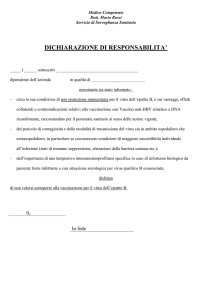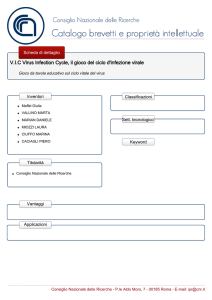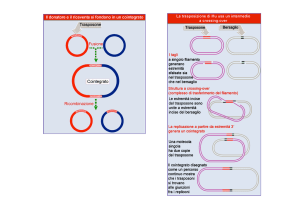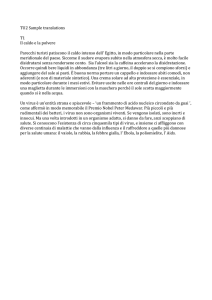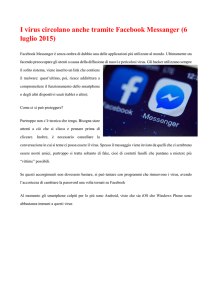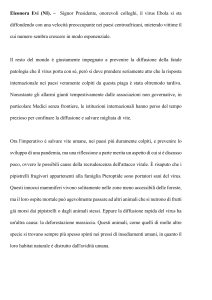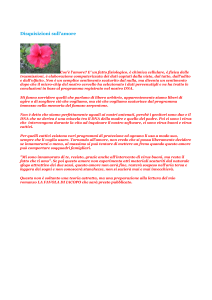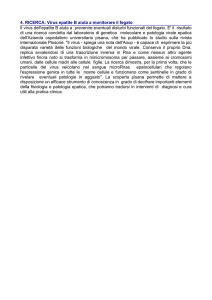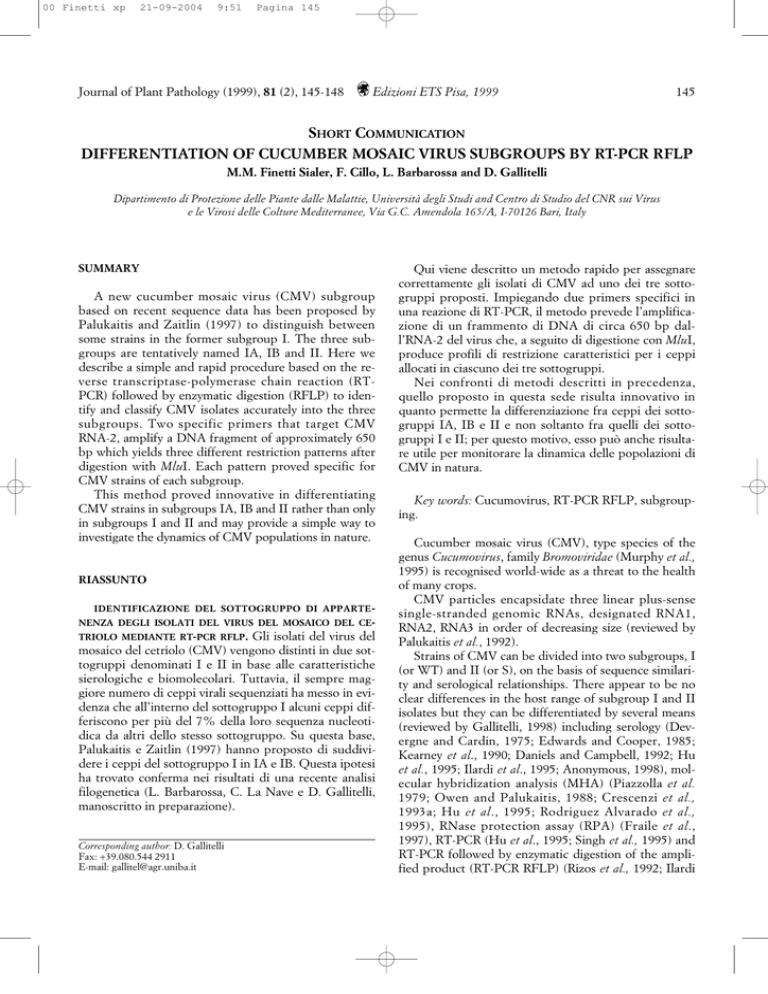
00 Finetti xp
21-09-2004
9:51
Pagina 145
Journal of Plant Pathology (1999), 81 (2), 145-148
Edizioni ETS Pisa, 1999
145
SHORT COMMUNICATION
DIFFERENTIATION OF CUCUMBER MOSAIC VIRUS SUBGROUPS BY RT-PCR RFLP
M.M. Finetti Sialer, F. Cillo, L. Barbarossa and D. Gallitelli
Dipartimento di Protezione delle Piante dalle Malattie, Università degli Studi and Centro di Studio del CNR sui Virus
e le Virosi delle Colture Mediterranee, Via G.C. Amendola 165/A, I-70126 Bari, Italy
SUMMARY
A new cucumber mosaic virus (CMV) subgroup
based on recent sequence data has been proposed by
Palukaitis and Zaitlin (1997) to distinguish between
some strains in the former subgroup I. The three subgroups are tentatively named IA, IB and II. Here we
describe a simple and rapid procedure based on the reverse transcriptase-polymerase chain reaction (RTPCR) followed by enzymatic digestion (RFLP) to identify and classify CMV isolates accurately into the three
subgroups. Two specific primers that target CMV
RNA-2, amplify a DNA fragment of approximately 650
bp which yields three different restriction patterns after
digestion with MluI. Each pattern proved specific for
CMV strains of each subgroup.
This method proved innovative in differentiating
CMV strains in subgroups IA, IB and II rather than only
in subgroups I and II and may provide a simple way to
investigate the dynamics of CMV populations in nature.
RIASSUNTO
IDENTIFICAZIONE DEL SOTTOGRUPPO DI APPARTE NENZA DEGLI ISOLATI DEL VIRUS DEL MOSAICO DEL CETRIOLO MEDIANTE RT-PCR RFLP.
Gli isolati del virus del
mosaico del cetriolo (CMV) vengono distinti in due sottogruppi denominati I e II in base alle caratteristiche
sierologiche e biomolecolari. Tuttavia, il sempre maggiore numero di ceppi virali sequenziati ha messo in evidenza che all’interno del sottogruppo I alcuni ceppi differiscono per più del 7% della loro sequenza nucleotidica da altri dello stesso sottogruppo. Su questa base,
Palukaitis e Zaitlin (1997) hanno proposto di suddividere i ceppi del sottogruppo I in IA e IB. Questa ipotesi
ha trovato conferma nei risultati di una recente analisi
filogenetica (L. Barbarossa, C. La Nave e D. Gallitelli,
manoscritto in preparazione).
Corresponding author: D. Gallitelli
Fax: +39.080.544 2911
E-mail: [email protected]
Qui viene descritto un metodo rapido per assegnare
correttamente gli isolati di CMV ad uno dei tre sottogruppi proposti. Impiegando due primers specifici in
una reazione di RT-PCR, il metodo prevede l’amplificazione di un frammento di DNA di circa 650 bp dall’RNA-2 del virus che, a seguito di digestione con MluI,
produce profili di restrizione caratteristici per i ceppi
allocati in ciascuno dei tre sottogruppi.
Nei confronti di metodi descritti in precedenza,
quello proposto in questa sede risulta innovativo in
quanto permette la differenziazione fra ceppi dei sottogruppi IA, IB e II e non soltanto fra quelli dei sottogruppi I e II; per questo motivo, esso può anche risultare utile per monitorare la dinamica delle popolazioni di
CMV in natura.
Key words: Cucumovirus, RT-PCR RFLP, subgrouping.
Cucumber mosaic virus (CMV), type species of the
genus Cucumovirus, family Bromoviridae (Murphy et al.,
1995) is recognised world-wide as a threat to the health
of many crops.
CMV particles encapsidate three linear plus-sense
single-stranded genomic RNAs, designated RNA1,
RNA2, RNA3 in order of decreasing size (reviewed by
Palukaitis et al., 1992).
Strains of CMV can be divided into two subgroups, I
(or WT) and II (or S), on the basis of sequence similarity and serological relationships. There appear to be no
clear differences in the host range of subgroup I and II
isolates but they can be differentiated by several means
(reviewed by Gallitelli, 1998) including serology (Devergne and Cardin, 1975; Edwards and Cooper, 1985;
Kearney et al., 1990; Daniels and Campbell, 1992; Hu
et al., 1995; Ilardi et al., 1995; Anonymous, 1998), molecular hybridization analysis (MHA) (Piazzolla et al.
1979; Owen and Palukaitis, 1988; Crescenzi et al.,
1993a; Hu et al., 1995; Rodriguez Alvarado et al.,
1995), RNase protection assay (RPA) (Fraile et al.,
1997), RT-PCR (Hu et al., 1995; Singh et al., 1995) and
RT-PCR followed by enzymatic digestion of the amplified product (RT-PCR RFLP) (Rizos et al., 1992; Ilardi
00 Finetti xp
146
21-09-2004
9:51
Pagina 146
RT-PCR RFLP of CMV
et al., 1995, Anonymous, 1998).
Recent sequence data show that a number of CMV
strains within subgroup I originating from Asia (here
referred to as ‘Asian strains’) differ by 7-12% in sequence from other subgroup I strains. On this basis,
Palukaitis and Zaitlin (1997) proposed to split subgroup I by placing the Asian strains in subgroup IB and
the others in subgroup IA. Strains in the same subgroup differ only by 2-3% in sequence homology.
In the Mediterranean basin, the economic importance of CMV correlates with recurrent outbreaks in
tomato crops (Gallitelli, 1998). In addition to the well
known fern leaf/shoestring and tomato necrosis (synonym: tomato lethal necrosis) diseases (Kaper and Waterworth, 1981; Palukaitis et al., 1992), tomato fruit
necrosis has been observed during CMV epidemics
(Jordà et al., 1992; Crescenzi et al., 1993).
In Italy, tomato fruit necrosis is consistently associated with a subgroup I strain (CMV-Tfn) which supports a 390 nucleotide satellite named Tfn-satRNA
(Crescenzi et al., 1993). The complete sequence of
CMV-Tfn has been determined (L. Barbarossa, C. La
Nave and D. Gallitelli, unpublished results) and its
phylogenetic relationships with other CMV strains, for
which complete sequences have been reported, also determined. The consensus trees clearly show that three
primary branches depart from the bulk of all CMV sequences, and virus strains cluster in three distinct subgroups. Within each subgroup, sequence heterogeneity
is 0-2% whereas intersubgroup differences are 7% or
more. Comparable consensus trees were obtained with
all CMV genomic RNAs within two extremes represented by CMV-RNA-2 (high differentiation) and CMV
CP sequence (poor differentiation). Thus, phylogenetic
analysis seems to support the existence of a third subgroup of strains and places CMV-Tfn among the Asian
strains, in subgroup IB (L. Barbarossa, C. La Nave and
D. Gallitelli, manuscript in preparation).
From this comparison it was noted that the MluI restriction map of RNA-2 of all CMV strains considered,
correlates with the three subgroups. In fact MluI restriction sites are not present in RNA-2 of subgroup IA
strains (CMV-MB8, Acc. no. D86613; CMV-O, Acc.
no. D10209; CMV-Y, Acc. no. D12538; CMV-Kor,
Acc. no. U66287; CMV-B, Acc. no. U59740; CMVLegume, Acc. no. D16406; CMV-Fny, Acc. no.
D00355) whereas one site (position 159) is present in
RNA-2 of strains of subgroup IB (CMV-Tfn, Acc. no.
Y16925; CMV-NT9, Acc. no. D2879; CMV-K, Acc. no.
S72187; CMV-As, Acc. no. AF033667; CMV-SD, Acc.
no. D86330) and two sites (positions 173 and 322) are
present in RNA-2 of subgroup II strains (CMV-Q, Acc.
no. X00985; CMV-S, Acc. no. Y10885; CMV- TrK7,
Journal of Plant Pathology (1999), 81 (2), 145-148
Acc. no. AJ007934). The exception is CMV-Ixora (Acc.
no. U20218) which clusters with subgroup IB strains,
according to our phylogenetic analysis, but does not
carry any MluI site.
Here we show that differentiation of CMV subgroups can readily be achieved by targeting RNA-2 sequences flanking MluI restriction sites with RT-PCR
RFLP.
Using primers synthesised on the basis of EMBL Data bank sequences, RNA preparations extracted from
purified virions of CMV strain S (subgroup II), Fny
(subgroup IA) (supplied by Dr. Peter Palukaitis, Scottish Crop Research Institute, Dundee, UK) and Tfn
(subgroup IB) were retrotranscribed to cDNA and then
amplified by 35 cycles of PCR. Three microlitres of
RNA preparation suspended in RNase-free water were
mixed with 50 pmol of the degenerate primer 5’GGTTCGAA(AG)(AG)(AT)ATAACCGGG-3’(RW8),
complementary to positions 618-637 of CMV-Fny
RNA-2, heated at 95°C for 3 min, chilled on ice and reverse-transcribed with 10 units of AMV reverse transcriptase (Amersham Life Science, UK) according to
the manufacturer. Ten µl of this mixture were subjected
to PCR amplification with 25 pmol of primer RW8, 50
pmol of the primer 5’-GTTTATTTACAAGAGCGTACGG-3’ (RV11), homologous to positions 1-22 of
CMV-Fny RNA-2, and 2.5 units of Taq polymerase
(Promega Corp., USA) as recommended by the manufacturer. DNA was amplified in a Perkin Elmer Cetus
thermal cycler with 1 cycle at 94°C for 4 min, followed
by 35 cycles at 94°C for 30 s, 64°C for 1 min, 72°C for 2
min. In the last cycle, time extension at 72°C was 10
min. Ten µl of the amplified product were digested
with 5 units of MluI (Boehringer Mannheim, Germany)
as recommended by the manufacturer and analysed by
electrophoresis in 1.2% agarose gel in 90 mM Tris, 90
mM boric acid, 1 mM NA2 EDTA, pH 8.3.
The RT-PCR RFLP assay amplified a DNA fragment
of approximately 650 bp for the three CMV strains
(Fig. 1, lanes a, c, e) which after digestion with MluI
yielded three distinct restriction patterns i.e. two fragments of approximately 470 and 160 bp for CMV-Tfn
(Fig. 1, lanes d, h), three fragments of approximately
320, 170 and 150 bp for CMV-S (Fig. 1, lanes f, i) and
one undigested sequence of approximately 650 bp for
CMV-Fny (Fig. 1, lanes b, g). Similar results were obtained when the RT-PCR RFLP protocol was applied to
DNA preparations extracted (White and Kaper, 1989)
from fresh or dried plant tissues infected by the same
CMV strains (not shown).
Since CMV-Ixora seemed exceptional in lacking the
MluI site present in all other subgroup IB strains, its
RNA-2 was amplified from an RNA preparation sup-
00 Finetti xp
21-09-2004
9:51
Pagina 147
Journal of Plant Pathology (1999), 81 (2), 145-148
plied by Dr. F. Cellini (Metapontum Agrobios, Italy)
and digested. The restriction pattern showed two fragments of ca 180 and 470 bp (not shown), proving that
this RNA contains an MluI site like other CMV strains
of subgroup IB. From analysis of the published sequence (McGarvey et al., 1995 and Acc. no. U20218) it
can be noted that a T/C substitution at position 180
should abolish the MluI site. This is in contrast with our
results and clearly indicates a cloning artefact, also because the C/T substitution necessary to restore the
MluI site does not disrupt the 2a ORF.
Three characterized CMV strains denoted CMVTTS (Grieco et al., 1992; Cillo et al., 1994), CMV-FL
(Crescenzi et al., 1993) and CMV-77 (Grieco et al.,
1997) and assigned to CMV subgroup I on the basis of
MHA were also analysed by the RT-PCR RFLP. Fig. 1
shows that amplified sequence of CMV-77 (lane j) was
not digested by MluI (lane k) whereas those of CMVFL and CMV-TTS (lanes l, n) yielded two fragments
of approximately 470 and 160 bp (lanes m, o). Thus
CMV-77 can be assigned to subgroup IA and CMV-FL
and CMV-TTS to subgroup IB.
The use of PCR with a single pair of CMV-specific
primers coupled with RFLP analysis of amplified sequences offers a simple and accurate means of identifying and grouping CMV isolates. As already mentioned,
Finetti Sialer et al.
147
this strategy has been successfully applied in several instances but the approach described here is innovative in
differentiating CMV strains in subgroups IA, IB and II
rather than only in subgroups I and II.
The method we have developed could be applied to
study the dynamics of CMV in natural populations.
This is an emerging necessity, since better knowledge of
CMV biodiversity may be fundamental in establishing a
correct baseline for risk assessment, in anticipation of
large scale deployment of transgenic virus-resistant
plants (Tepfer and Balazs, 1997).
ACKNOWLEDGEMENTS
We thank prof. G.P. Martelli for critically reading
the manuscript.
This work was supported by a grant of the Italian
Ministry for University and Scientific and Technological Research (MURST) PNR ‘Virosi e fitoplasmosi di
colture agrarie di rilevante importanza economica:
caratterizzazione biologica e possibilità di prevenzione’
and by a grant from the University of Bari ‘Studio delle
interazioni virus-ospite e caratterizzazione biologicomolecolare di virus di rilevante importanza per le colture meridionali’.
Fig. 1. Electrophoretic analysis in 1.2% agarose gel of amplified products (lanes a, c, e, j, l, n) and respective restriction patterns
(lanes b, d, f, g, h, i, k, m, o) obtained for the following strains of CMV: Fny (lanes a, b, g), Tfn (lanes c, d, h), S (lanes e, f, i), 77
(lanes j, k), FL (lanes l, m), TTS (lanes n, o). M: 100 bp ladder (BRL); H2O: negative control, no RNA.
00 Finetti xp
148
21-09-2004
9:51
Pagina 148
RT-PCR RFLP of CMV
REFERENCES
Journal of Plant Pathology (1999), 81 (2), 145-148
F., 1992. Epidemics of CMV plus satellite RNA in tomatoes in eastern Spain. Plant Disease 76: 363-366.
Anonymous. 1998. Detection of biodiversity of cucumber mosaic cucumovirus. Conclusions from a Ringtest of European Union Cost 823 (New technologies to improve phytodiagnosis). Journal of Plant Pathology 80: 133-150.
Kaper J.M., Waterworth H.E., 1981. Cucumoviruses. In:
Kurstak E. (ed.). Handbook of Plant Virus Infections and
Comparative Diagnosis, pp. 257-332. Elsevier/North Holland Biomedical Press, Amsterdam.
Cillo F., Barbarossa L., Grieco F., Gallitelli D., 1994. Lethal
necrosis, fruit necrosis and top stunting: molecular biological aspects of three cucumber mosaic virus-induced diseases of processing tomatoes in Italy. Acta Horticulturae
376: 369-376.
Kearney C.M., Zitter T.A., Gonsalves D., 1990. A field survey
for serogroups and the satellite RNA of cucumber mosaic
virus. Phytopathology 80: 1238-1243.
Crescenzi A., Barbarossa L., Cillo F., Di Franco A., Vovlas
N., Gallitelli D., 1993. Role of cucumber mosaic virus and
its associated satellite RNA in the etiology of tomato fruit
necrosis in Italy. Archives of Virology 131: 321-333.
Crescenzi A., Barbarossa L., Gallitelli D., Martelli G.P.,
1993a. Cucumber mosaic cucumovirus populations in Italy
under natural epidemic conditions and after a satellite-mediated protection test. Plant Disease 77: 28-33.
Daniels J., Campbell R.N., 1992. Characterization of cucumber mosaic virus isolates from California. Plant Disease 76:
1245-1250.
Devergne J.C., Cardin L., 1975. Relations serologiques entre
cucumovirus (CMV, TAV, PSV). Annales de Phytopathologie 7: 255-276.
Edwards M., Cooper J.I., 1985. Plant virus detection using a
new form of indirect ELISA. Journal of Virological Methods 11: 309-319.
Fraile A., Alonso Prados J.L., Aranda M.A., Bernal J.J.,
Malpica J.M., Garcia Arenal F., 1997. Genetic exchange
by recombination or reassortment is infrequent in natural
populations of a tripartite RNA plant virus. Journal of Virology 71: 934-940.
Gallitelli D., 1998. Present status of controlling cucumber
mosaic virus. In: Khetarpal R.K., Koganezawa, Hadidi A.
(eds.). Control of Plant Virus Diseases, pp. 507-523. APS
Press, St. Paul, MN.
Grieco F., Cillo F., Barbarossa L., Gallitelli D., 1992. Nucleotide sequence of a cucumber mosaic virus satellite
RNA associated with a tomato top stunting. Nucleic Acids
Research 20: 6733.
Grieco F., La Nave C., Gallitelli D., 1997. Evolutionary dynamics of cucumber mosaic virus satellite RNA during
natural epidemics in Italy. Virology 229: 166-174.
Hu J.S., Li H.P., Barry K., Wang M., Jordan R., 1995. Comparison of dot blot ELISA and RT-PCR assays for detection of two cucumber mosaic virus isolates infecting banana in Hawaii. Plant Disease 79: 902-906.
Ilardi V., Mazzei M., Loreti S., Tomassoli L., Barba M., 1995.
Biomolecular and serological methods to identify strains of
cucumber mosaic cucumovirus on tomato. EPPO Bulletin
25: 321-327.
Jordà C., Alfaro A., Aranda M.A., Moriones E., Garcia Arenal
McGarvey P., Tousignant M., Geletka L., Cellini F., Kaper
J.M., 1995. The complete sequence of cucumber mosaic
virus from Ixora that is deficient in the replication of satellite RNAs. Journal of General Virology 76: 2257-2270.
Murphy F.A., Fauquet C.M., Bishop D.H.L., Ghabrial S.A.,
Jarvis A.W., Martelli G.P., Mayo M.A., Summers M.D.,
1995. Virus taxonomy- Sixth report of the International
Committee on Taxonomy of Viruses. Archives of Virology
(Supplement 10): 450-456.
Owen J., Palukaitis P., 1988. Characterization of cucumber
mosaic virus I. Molecular heterogeneity mapping of RNA
3 in eight CMV strains. Virology 166: 495-502.
Palukaitis P., Roossinck M.J., Dietzgen R.G. Francki R.I.B.,
1992. Cucumber mosaic virus. Advances in Virus Research
41: 281-342.
Palukaitis P., Zaitlin M., 1997. Replicase-mediated resistance
to plant virus disease. Advances in Virus Research 48: 349377.
Piazzolla P., Diaz-Ruiz J.R., Kaper J.M., 1979. Nucleic acid
homologies of eighteen cucumber mosaic virus isolates determined by competition hybridization. Journal of General
Virology 45: 361-369.
Rizos H., Gunn L.V., Pares R.D. Gillings M.R., 1992. Differentiation of cucumber mosaic virus isolates using the polymerase chain reaction. Journal of General Virology 73:
2099-2103.
Rodriguez Alvarado G., Kurath G., Dodds J.A., 1995. Heterogeneity in pepper isolates of cucumber mosaic virus.
Plant Disease 79: 450-455.
Singh Z., Jones R.A.C., Jones M.G.K., 1995. Identification of
cucumber mosaic virus subgroup I isolates from banana
plants affected by infectious chlorosis disease using RTPCR. Plant Disease 79: 713-716.
Tepfer M. Balazs E., 1997. Concluding remarks and recommendations. In: M. Tepfer, E. Balazs (eds.).Virus-resistant
transgenic plants: potential ecological impact., pp. 121123. INRA Editions, Springer-Verlag, Berlin Heidelberg.
White J.L., Kaper J.M., 1989. A simple method for detection
of viral satellite RNAs in small tissue samples. Journal of
Virological Methods 23: 83-94.
Received 16 February 1999
Accepted 17 May 1999

